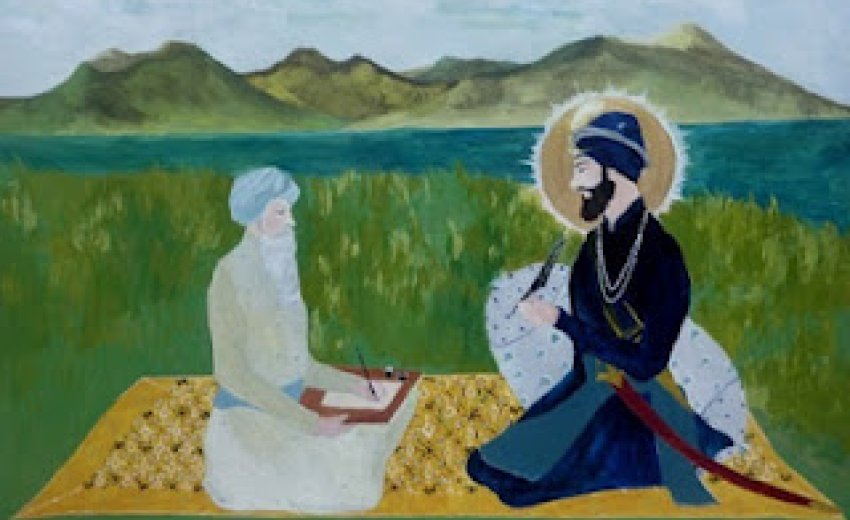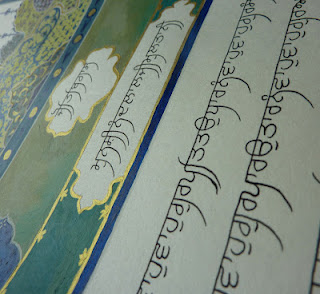|
The Guru of Bhai Nand Lal The many works of Bhai Nand Lal reveal his intimate and mystical knowledge of the Sikh faith. Amongst these, one particular Rehitnama outlines the threefold nature of Guru Gobind Singh's being as it was narrated to the poet in person.
Sunday, August 12, 2012: From the late 1680's onwards, the young Guru Gobind Rai assembled an entourage of scholars in the majestic cities of Paonta and Anandpur. Though the traditional accounts mention 52 scholar-poets, new research indicate that more than a hundred scholars, poets and scribes settled at various periods in the courts of the tenth Guru to compose scholarly treaties, spiritual works, poetry etc.. Amongst these, the most outstanding was the Afghan-born Bhai Nand Lal Goya. In the late 1695, four years prior to the establishment of the Khalsa order, Bhai Nand Lal and Guru Gobind Rai sat at the banks of the Satluj river in Anandpur. Here, the Guru dictated a rehitnama while Bhai Nand Lal humbly listened to the words of his Master. Towards the end of the conversation, Bhai Nand Lal entitled the document: Prashan Uttar (Question and Answers). Prashan Uttar Rehitnama Nirgun (The Invisible) Sargun (the Granth) In these words, the Guru is echoing the words of Guru Har Krishan who similarly, according to the Suraj Parkash, in Delhi said 'The Granth is the Lord of all. He who wants to see Me, let him with faith and love see the Granth. So will he shed all his sins. He who would wish to speak with the Guru, let him read the Granth with devotion. He who practises its teachings will obtain all the four cherished objects of human life. In the Granth abides the Guru's spirit. Daily bow your head to it. So will you conquer your passions and attain liberation'. As these words reveal, an intimate relationship is to be acquired between the Sikh and the all pervasive Guru via the Words enshrined in the Granth. As such, the Granth becomes a vehicle to establishing a relationship with the Eternal Word of the Satguru. In the Persian Jot Bigâs, praise is also given to the Shabad in a long eulogy of the unity of Gurus: 'Guru Gobind Singh and Guru Nanak are one and the same; Their words (shabad) and message are like pearls and diamonds. Their words are like precious jewels that have been tempered with Truth (Haqq Jalâ); Their words are like a diamond that has been blessed with the shine of Truth'. Gurshabad (the devout Sikh) For Bhai Nand Lal, the Sangat does not merely consist of a group of individuals engaged in spiritual practices,- rather they become the very body of the Guru. This is expressed in his lengthy Persian composition Zindaginamâ, wherein a dozen paragraphs are dedicated to the Sangat alone whom he regards as the real Men of Truth (Mardân-e-Haqq) and the people of God (Mardân-e-Khudâsat). In his description of the Sangat, he regards them as men and women of high moral standards engaged in spiritual practices, rising above their base desires, producing literature and great eloquent speakers while they inspire others to the Truth. The Guru of Bhai Nand Lal Bhai Nand Lal in later Sikh tradition After his death in 1712, Bhai Nand Lal continued to be held in high esteem for many generations. The famous Sikh historian Saroop Das Bhalla, writing in 1775, captures the contemporary spirit and tradition well in his Mahima Prakash. Captured by the poet's subtle personality, mystic inclinations and wisdom, Saroop Das Bhalla writes:
Through contact with the Philosopher's stone iron turns into gold. A devotee is both agreeable and happy when he meets with the true guru who looks upon him mercifully. At that moment the resplendent light of the divine shines in the heart. Such contact ensures that one is free from doubt and his heart and mind achieve samadhi, a condition of deep meditation, and from the great bewitching sleep he is awakened. Bhai Nand Lal was one such beloved. As Guru Nanak says of such devotees: 'It is through the grace of the Lord, the one who bestows grace, O Nanak, that one becomes blessed. The rehitnama Prashan Uttar is a short and simple yet deep document that ought to come to light amongst mainstream Sikhs. We strongly encourage the readers to become familiar with this document and to study it in order to gain a deeper understanding of the nature of the Guru. This article is a part of a series of articles to highlight the personality, life and works of Bhai Nand Lal. The year 2012 marks the 300 year death tricentenary of Bhai Nand Lal and during the year, articles, Persian and Gurmukhi calligraphy, arts and a website will be published. As a first step of achieving this goal, a Facebook page has been set up which sends out a daily quote from the Diwân-e-Goya. Visit link below to become a fan of this page and receive a daily quote on your wall. https://www.facebook.com/Bhainandlal |



 The second form of the Guru is the Granth. This is a well known notion amongst Sikhs of today, but Bhai Nand Lal takes the notion one step further by adding an element of intimacy between the Guru and the Granth itself. In the rehitnama, Guru Gobind Singh says that 'The person who wishes to converse with Me should read the Granth and reflect on what it says. The person who wishes to hear My words should devoutly hear and reflect on the Granth. Acknowledge the Granth as My visible presence , and reject the notion that it is any other than Me'.
The second form of the Guru is the Granth. This is a well known notion amongst Sikhs of today, but Bhai Nand Lal takes the notion one step further by adding an element of intimacy between the Guru and the Granth itself. In the rehitnama, Guru Gobind Singh says that 'The person who wishes to converse with Me should read the Granth and reflect on what it says. The person who wishes to hear My words should devoutly hear and reflect on the Granth. Acknowledge the Granth as My visible presence , and reject the notion that it is any other than Me'. In the light of the writings of Bhai Nand Lal, the Guru has three forms, the invisible/unmanifested, the visible/manifested and the devout Sikhs. All of these make up a trinity of the Guru's being. These three forms of the Guru are elaborated upon in Gurbani and the works of Bhai Gurdas and as such, the writings of Bhai Nand Lal are a clear testament to his great awareness and intimacy of the deeper and subtler aspects of Sikh philosophy. The writings of Bhai Nand Lal in general, written in the subtle classical Persian language, challenge us to constantly read and renew our commonly held perceptions on the Sikh religion.
In the light of the writings of Bhai Nand Lal, the Guru has three forms, the invisible/unmanifested, the visible/manifested and the devout Sikhs. All of these make up a trinity of the Guru's being. These three forms of the Guru are elaborated upon in Gurbani and the works of Bhai Gurdas and as such, the writings of Bhai Nand Lal are a clear testament to his great awareness and intimacy of the deeper and subtler aspects of Sikh philosophy. The writings of Bhai Nand Lal in general, written in the subtle classical Persian language, challenge us to constantly read and renew our commonly held perceptions on the Sikh religion.